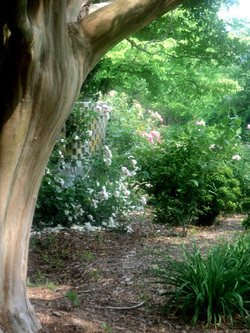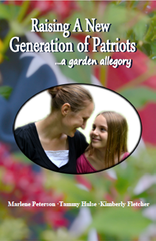The Garden Allegory

By observing the cycles of nature as portrayed in the seasons and in the process of gardening, we discover how energy travels through the growth and development process. The Master Gardener works with this natural cycle by following a simple five step process each year:
1. Select seeds for planting
2. Prepare the soil and plant the seeds
3. Nourish and cultivate the tender plants
4. Pull away the weeds
5. Share the harvest
Energy travels through the mind and heart in a similar sequence. The Garden Allegory identifies a simple five-step process that can be applied to learning and growth. This simple model contains metaphors that are easily understood by the beginning teacher and yet deep enough to provide educational insights for a lifetime. This process can be applied to all learning. Students may use this process to learn a math concept, a scientific principle, or a religious doctrine. It can also be applied to acquire new skills and talents and to develop virtues and values within a person's character.
1. Select seeds for planting
2. Prepare the soil and plant the seeds
3. Nourish and cultivate the tender plants
4. Pull away the weeds
5. Share the harvest
Energy travels through the mind and heart in a similar sequence. The Garden Allegory identifies a simple five-step process that can be applied to learning and growth. This simple model contains metaphors that are easily understood by the beginning teacher and yet deep enough to provide educational insights for a lifetime. This process can be applied to all learning. Students may use this process to learn a math concept, a scientific principle, or a religious doctrine. It can also be applied to acquire new skills and talents and to develop virtues and values within a person's character.
The Five Points of Learning
Facilitating harmony between the mind and heart
The Five Points of Learning is an educational tool to use when students are ready to learn about specific topics with a more systematic approach, such as reading and writing, math, or science. When children have enjoyed the benefits heart warming experiences during the core years, their hearts and minds will be well prepared to explore specific topics of study. Parents will know when children are ready to add a more systematic approach to learning because they will ask questions and express a desire to learn.
By following a natural course of growth as depicted in the garden allegory and inviting the mind to participate in the analytical part of learning, we facilitate a partnership between the heart and mind where they can work in harmony with one another. As students complete the steps in the cycle, the things they learn become part of the "heart memory" where it can be retained for a lifetime and contribute to the development of greater wisdom and understanding.
By following a natural course of growth as depicted in the garden allegory and inviting the mind to participate in the analytical part of learning, we facilitate a partnership between the heart and mind where they can work in harmony with one another. As students complete the steps in the cycle, the things they learn become part of the "heart memory" where it can be retained for a lifetime and contribute to the development of greater wisdom and understanding.
|
This simple model of the Garden Allegory contains metaphors that are easily understood by the beginning teacher and yet deep enough to provide educational insights for a lifetime.
For additional insights about the Garden Allegory, see our book "Raising a New Generation of Patriots" available on the store page of the MFA website.
|
The following five points of learning are encouraged and incorporated into many of the resources on the Hearthstone Education Plan: 1. Define Principle or Concept (Seed Selection) Students are allowed to choose a topic that interests them. Mentors and teachers may also identify and define the principle that will be studied during the next week. 2. Discovery (Soil Preparation and Planting) Parents are encouraged to provide an inspiring environment where students are free to explore and ask questions. Students will increase their learning if they take the time to ask lots of questions. Write down all the "facts" you think you already know about your subject. Make a list of all the things you would like to learn about your subject. Encourage students to ask questions that starts with each of these words. Can you use them all? what, why, when, where, who, was, which, would, were, how, is, do, does, did, may, are, could, shall, will, can, have, if Keep adding to your list of questions while you carry out your investigation. The discovery phase will be enhanced by related stories, discussions at family dinner, field trips, and family learning projects. 3. Skill Practice & Service (Nourish the plants with water and nutrients) Every gardener knows that seeds must be nourished and watered during the season if the plants are going to grow to their full potential. Educational seeds must also be nourished. Students, parents, and teachers may work together to design a learning experience that allows plenty of time for practice of the principle or concept being studied. 4. Evaluate, Organize & Apply (Pull out unwanted weeds) During this step, students practice discerning truth from error, organizing their thoughts, and applying the principles to everyday life. Through evaluation, discussion, and story problems. students can discover how and when to apply the principles most effectively. 5. Create (Share the Harvest) After students have discovered and understood a principle at a deeper level, they are invited to think of a creative, interesting way to share their new knowledge with their class, relatives, and friends. They are encouraged to prepare a presentation with visual aids, write a speech or a poem, create a piece of artwork, etc. Some ideas are listed below:
Capture the Sunshine: An image of a sun is in the middle of the Five Points of Learning graphic to remind teachers and mentors of the importance of learning in an environment of light and truth. As students participate in the cycle, parents and teachers can provide guidance and encouragement to:
|

